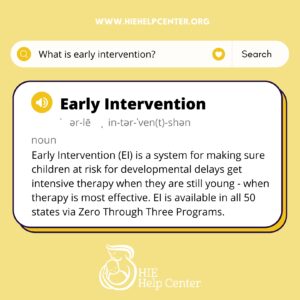Children’s brains develop rapidly between birth and three years of age. Researchers have created lists of developmental milestones that children should be reaching during these formative years. If a child misses some of these milestones, it’s possible they may have a developmental delay. Parents should talk to their pediatrician if they think this is the case for their child. Pediatricians can refer them to specialized services and resources. The umbrella term for services and supports that are available for children ages 0-3 with developmental delays and disabilities is called “early intervention” (1).

Each state has a department set aside specifically for providing early intervention services to children who either have known developmental delays or are at risk for developing delays. A child is at risk for a developmental delay if they have a health condition that will probably lead to that delay (such as cerebral palsy, a birth injury, hypoxic-ischemic encephalopathy, a genetic disorder, or others) (2).
Early intervention programs are publicly funded and normally provided to families in need for free or at a reduced cost (1). These services are provided under IDEA Part C (for children ages 0-3) (3). While the programs are available to all children with a risk of developmental delay, it is the responsibility of parents to enroll their child in these programs. This can be done by asking your child’s pediatrician or care provider for a referral to the service. You can also search for early intervention programs and reach out to them directly using the list on the Center for Disease Control and Prevention Early Intervention page.
Jump to:
- What do early intervention programs do?
- Transitioning out of early intervention
- Do you need someone to talk to?
What do early intervention programs do?
 If your state deems your child eligible for their early intervention services, the program then makes a document called an Individualized Family Service Plan (IFSP). This plan outlines what areas of development may need some extra work, and explains what kinds of services the child needs to address those delays.
If your state deems your child eligible for their early intervention services, the program then makes a document called an Individualized Family Service Plan (IFSP). This plan outlines what areas of development may need some extra work, and explains what kinds of services the child needs to address those delays.
Then, the parents start putting together a team of people to help carry out the goals in the plan. Who is included in the team can vary, but usually it includes the parents, medical providers, therapists, social workers, and other relevant parties. The plan also includes information about the following topics:
- How often the child will be evaluated for progress
- Who will pay for services
- A timeline for when services will be delivered
What types of early intervention services are available?
Early intervention services address the specific needs of the child with developmental disabilities and their family. They can do this through a variety of different services, including (2, 3):
- Counseling
- Family training
- Home visits
- Hearing or vision services
- Physical therapy
- Occupational therapy
- Assistive technology
- Speech/language pathology
- Nutrition services
- Social work
- Transportation
Usually, these plans are re-evaluated every six months, but it can be sooner if parents find that their child needs more assistance than previously assumed.
Transitioning out of early intervention

Early intervention services end when the child turns three. A few months before the child turns three, your early intervention team will talk about transition. Your child may then be eligible for special education in preschool and continued special education throughout their schooling, so it’s important to discuss what’s next.
In order to receive special education and support services, the child must be evaluated for disabilities by the child’s school district. Parents can request that the school district provide this evaluation for their child when the child is as young as three years old, though evaluation can also be requested at any time during the child’s academic career.
If parents don’t agree with the school district’s evaluation, they can then request an Independent Education Evaluation (IEE), where an independent professional evaluates the child’s educational needs, barriers to getting those needs fulfilled, and potential solutions to overcoming these barriers.
Getting your child an Individualized Education Plan (IEP)
If the child’s evaluation shows developmental delays, a team will begin creating an Individualized Education Plan (IEP), which outlines the services the child should be receiving as part of special education programs. At this point, parents can also involve the child’s preschool or pre-K teachers in order to pave the way for an easy transition to school. An IEP may be developed well before a child begins schooling, so parents can be aware of their children’s educational needs well in advance. Once a child reaches age 5, they will transition into schooling; at this point, having an IEP gives them a specific advantage because the schools will know precisely what services they need to provide the child in order for them to thrive.
Do you need someone to talk to?
Your child was just diagnosed with a disability and your head is spinning with questions, medical terms, care plans, special education; it can be difficult to make sense of everything that has happened. As you start to do your research on exactly what your child’s diagnosis means, you will be bombarded with facts, information, and advice, and you may be lost as to where to turn next.
We want to hear your story. HIE Help Center is owned by ABC Law Centers (a birth injury law firm). The intake team at ABC Law Centers is here to listen to every detail of what you and your family may have gone through during labor and delivery. Although we are not doctors and cannot provide medical advice, our team can provide you with resources specifically tailored to your situation. Our team has reviewed and handled thousands of cases and is trained to recognize if there may have been medical malpractice that lead to your child’s diagnosis, and we can advise if taking legal action may be beneficial to you and your family.
Call us at (888) 329-0122 to speak with a member of our intake team.
Related Resources
- Special Education and Individualized Education Plans (IEPs)
- IEPs and the Transition Between Life Stages
- Physical Therapy for Hypoxic-Ischemic Encephalopathy Injuries
- Occupational Therapy for Hypoxic-Ischemic Encephalopathy Injuries
- Behavioral Therapy
- Speech-Language Pathology
- Assistive and Adaptive Technologies
Sources
- What is “Early Intervention”? | CDC. Retrieved from https://www.cdc.gov/ncbddd/actearly/parents/states.html
- Stuart, A. Early Intervention: What It Is and How It Works. Retrieved from https://www.understood.org/en/learning-attention-issues/treatments-approaches/early-intervention/early-intervention-what-it-is-and-how-it-works
- Individuals with Disabilities Education Act (IDEA) Services | CDC. Retrieved from https://www.cdc.gov/ncbddd/cp/treatment.html

